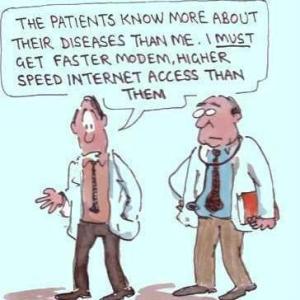
Article from "The Rheumatologist" official publication of the ACR
by Matthew J. Koster, MD, & Kenneth J. Warrington, MD
Case
A
28-year-old woman presents for evaluation of exhaustion, widespread
myalgias and muscle spasms. In addition, she has numerous symptoms
spanning multiple organ systems, including paresthesia, atypical chest
pain and abdominal bloating. She has previously undergone evaluation at
other medical centers and by multiple subspecialists, and no specific
pathology or diagnosis has been established. She has difficulty
continuing her employment due to disabling symptoms. A comprehensive
evaluation for malignancy and infectious diseases has been unrevealing.
Neurological evaluation, including detailed physical examinations,
imaging of the brain, electromyography and testing for large- and
small-fiber neuropathy, has been negative. Extensive laboratory studies,
autoimmune serologies and radiographic imaging studies are
unremarkable.
You review the history and conduct a comprehensive
physical examination and find no abnormalities, except for widespread
muscle tenderness without weakness. The patient is not reassured by the
negative evaluation and is concerned that a progressive autoimmune
disorder is being missed. Additional evaluation is pursued, including
magnetic resonance imaging (MRI) of proximal muscles, which is negative.
The patient requests further testing, including a muscle biopsy. Her
request conflicts with your recommendation that the diagnostic
evaluation has been completed and your plan to pursue symptomatic
management for fibromyalgia.
Dilemma
As access to medical
information expands, patients increasingly present to clinical
encounters with specific preconceptions regarding their possible
diagnosis and requests for testing and interventions. Medical literacy,
if applied appropriately, can lead to patient education and empowerment,
and can improve shared decision making. However, if the information
obtained is of questionable accuracy, incomplete, misinterpreted or
outdated, such requests and expectations can lead to challenging
clinical encounters, especially when the patient’s preconceptions differ
from the physician’s assessment.
How should physicians approach
patient requests for testing deemed unnecessary or even contraindicated
in a manner that respects patient preferences, upholds a physician’s
integrity and maintains a strong physician–patient relationship?
Discussion
On
the surface, the patient’s request in the above scenario may seem
morally innocuous; however, it has complex ethical undertones involving
patient autonomy, physician professionalism, knowledge asymmetry,
medical uncertainty and defensive medicine.
Should additional testing be performed in this patient?
The
patient in this clinical scenario has fibromyalgia. Comprehensive
examination and testing have already been performed to rule out other
conditions for the cause of pain, one of the criteria for the diagnosis
of this condition.1 Muscle biopsy studies show there are no specific
changes conclusive for fibromyalgia.2 Additional testing in the
evaluation of such patients should be prompted primarily by clinical
suspicion and objective physical findings. Excessive and repeated
testing may have a negative effect on the patient’s well-being and
encourage medicalization.3 In the absence of findings concerning for
inflammatory myopathy, muscular dystrophy or metabolic muscle disease,
muscle biopsy would not be indicated and, thus, can be considered
medically unnecessary in this case.
Matthew Koster
Matthew Koster
What are positive & negative rights?
When
patient requests conflict with a physician’s concept of acceptable
practice, it’s important to examine the distinction between positive and
negative rights.4 When considering medical encounters, most ethicists
focus on patient autonomy in terms of negative rights—that is, the right
to decline a treatment or test.
The American Medical Association
Code of Ethics states the patient has the right to make decisions
regarding the healthcare that is recommended by his or her physician.
Accordingly, patients may accept or refuse any recommended medical
treatment.5 The emphasis of informed consent promotes appropriate
barriers to prevent patients from receiving care or interventions that
are contrary to their desires or beliefs. Respect for patient autonomy,
however, also governs positive rights—the right that something be done.
Much less guidance is provided to physicians in this regard. If
physicians are to respect patient autonomy by way of positive rights,
how are physicians ever justified in denying a patient’s request?
According
to the ACP Ethics Manual, the patient–physician relationship entails
special obligations for the physician to serve the patient’s interest
because of the specialized knowledge that physicians possess, the
confidential nature of the relationship, and the imbalance of power
between patient and physician.6
In this case scenario, the
patient’s autonomous decision conflicts with the physician’s
professional duty to look out for the patient’s best interests and
welfare (i.e., beneficence). Therefore, we must carefully consider the
balance between respecting the patient’s right to share in the medical
decision making and the physician’s responsibility to avoid patient harm
(i.e., nonmaleficence). This patient is so worried about having an
autoimmune disease that her quality of life is compromised. When
patients request diagnostic studies that are not indicated, physicians
should first seek to understand the reason for the request. Then, the
physician should educate the patient about his or her rationale for not
recommending the test based on the physician’s specific knowledge and
medical expertise for which the patient is seeking counsel.
When
the risk of harm to the patient significantly exceeds the potential
diagnostic utility of an intervention, the physician has to keep in
focus one of the principal precepts of bioethics: primum non nocere
(first, do no harm).
Kenneth Warrington
Kenneth Warrington
What
if, despite education of medical necessity & risk-benefit ratio of
intervention, the patient continues to insist on the nonindicated
intervention?
If the principles of patient autonomy, beneficence
and nonmaleficence were the only factors being weighed in such
encounters, physicians may convince themselves that acquiescence to
patient requests can be justified on grounds that reduction of anxiety
alone may tip the risk-benefit scale toward intervention.
However,
in the current case, it seems doubtful that another negative test would
be the end of her requests. In addition, it is increasingly apparent in
our current healthcare environment that medically unnecessary testing
cannot be sustained, and the ethical tenet of distributive justice must
also be considered. The principle of distributive justice implies that
healthcare resources should be distributed fairly in society. Therefore,
although an additional laboratory test, imaging study or procedure may
seem insignificant, when magnified on a national scale, the economic
cost of these “inconsequential” decisions becomes large. It is not
unethical to withhold nonindicated treatment, and one of the reasons is
the pursuit of distributive justice.
We must carefully consider
the balance between respecting the patient’s right to share in the
medical decision making & the physician’s responsibility to avoid
patient harm.
But what if I decline a test & miss something diagnosable?
Societal,
legal and professional pressures add to physicians’ fear of missing a
diagnosis. This is compounded in disorders when symptoms are purely
subjective. When dealing with medical uncertainty associated with vague
or subjective symptoms, physicians may agree to patient requests that do
not present undue risk to the patient. However, the testing should be
rational, medically justified and part of a comprehensive,
well-documented management plan.
Back to the Patient
A
critical goal of this patient’s physician is to reassure her that there
is not an underlying disease being missed. The assumption in this
encounter is that the patient feels information that can be obtained
from a biopsy is more convincing than the physician’s clinical judgment
regarding her diagnosis.
Additional investigation into the
patient’s request reveals some important information: A friend was
recently diagnosed with polymyositis, and she is concerned she may have
this as well. After review of her current workup, education about
fibromyalgia and its differences from autoimmune disorders, as well as
the risk of the procedure compared with the expected benefit, the
patient ultimately agrees a muscle biopsy is not required. Although she
is still apprehensive about her diagnosis, she agrees to initiate a
treatment plan with the reassurance that she will have ongoing
monitoring for any changes in symptoms and reevaluation as
necessary—plans that can only be implemented in the context of a strong
physician–patient relationship.
Have you had an experience in
which patients requested tests or treatment that you felt was not
indicated? How did you handle the request? If you have comments or
questions about this case, or if you have a case that you’d like to see
in Ethics Forum, e-mail us at klosavio@wiley.com.
Matthew J. Koster, MD, is a second-year rheumatology fellow at Mayo Clinic, Rochester, Minn.
Kenneth
J. Warrington, MD, is an associate professor of medicine and practice
chair of rheumatology at Mayo Clinic, Rochester, Minn. He is a member of
the ACR’s Committee on Ethics and Conflict of Interest.
Acknowledgment
The authors thank Dr. Robert H. Shmerling, MD, for his critical review of the manuscript.
References
Wolfe
F, Clauw DJ, Fitzcharles M-A, et al. The American College of
Rheumatology preliminary diagnostic criteria for fibromyalgia and
measurement of symptom severity. Arthritis Care Res. 2010
May;62(5):600–610.
Bengtsson A. The muscle in fibromyalgia. Rheumatology. 2002 Jul;41(7):721–724.
Fitzcharles
M-A, Ste-Marie PA, Goldenberg DL, et al. Canadian Pain Society and
Canadian Rheumatology Association recommendations for rational care of
persons with fibromyalgia. A summary report. J Rheum. 2013
Aug;40(8):1388–1393.
Beauchamp TL, Childress JF. Principles in Bioethics. New York: Oxford University Press. 1979:50.
AMA Council on Ethical and Judicial Affairs. Code of Medical Ethics of the American Medical Association, 2012–2013.
Snyder
L. American College of Physicians Ethics, Professionalism, and Human
Rights Committee. American College of Physicians Ethics Manual, 6th Ed.
Ann Intern Med. 2012 Jan 3;156(1 Pt 2):73–104.
http://www.the-rheumatologist.org/details/article/6480961/Patient_Test_Requests_Pose_Challenges_for_Rheumatologists.html



